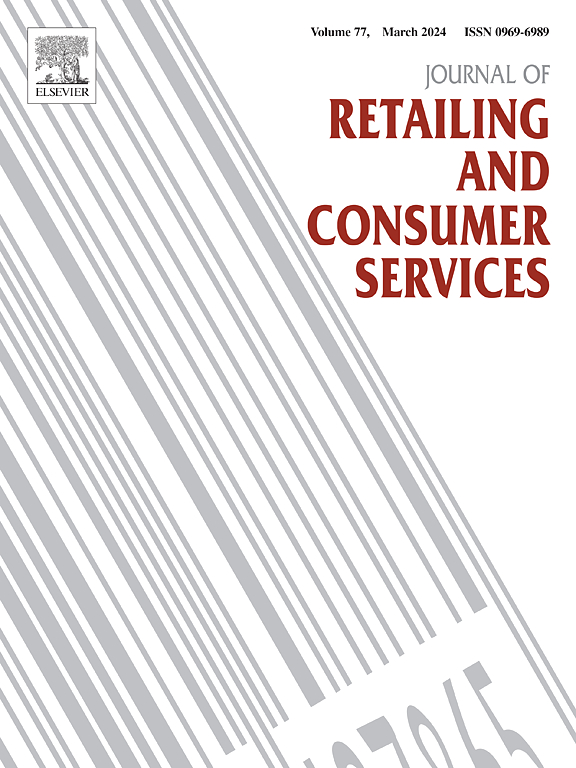主播直播对商家直播有利吗?前后努力的效果
IF 11
1区 管理学
Q1 BUSINESS
Journal of Retailing and Consumer Services
Pub Date : 2025-04-30
DOI:10.1016/j.jretconser.2025.104314
引用次数: 0
摘要
在数字商务时代,直播已经成为必不可少的销售渠道,这促使制造商在商家员工、低影响力主播(L-streamers)和高影响力主播(H-streamers)之间进行战略性选择。很少有研究比较分析销售努力和动态佣金率对制造商盈利能力和渠道选择的影响。本研究通过建立一个双通道模型来评估这两种激励机制,从而弥补了这一差距。结果表明,在相同的佣金率下,l流主播始终比商家员工产生更高的利润,而h流主播仅在通过直播轻松销售的产品中获得更高的佣金率。此外,在相同的佣金率下,l -streamer比h -streamer产生更高的利润。在努力后情景下,提高佣金率会激励主播和员工的销售努力,显著影响制造商的渠道偏好。具体来说,制造商更喜欢佣金率较低的商人雇员,而转向佣金率较高的l -streamer。商家员工和h -streamer之间的选择取决于产品特性、麻烦成本和负效用因素:h -streamer在容易销售的产品中获得更高的佣金率,而当传统在线渠道保留明显优势时,商家员工更受青睐。此外,制造商对前期和后期方案的偏好因麻烦成本和佣金率而异。我们的分析证明了动态佣金结构相对于销售努力激励的有效性,指导制造商优化渠道策略和佣金结构,以实现持续盈利和渠道稳定。本文章由计算机程序翻译,如有差异,请以英文原文为准。
Is streamer live-stream favorable to merchant live-stream? The effect of pre- and post-effort
In the digital commerce era, live-stream has become an essential sales channel, prompting manufacturers to strategically select among merchant employees, low-influence streamers (L-streamers) and high-influence streamers (H-streamers). Few studies comparatively analyze how sales effort and dynamic commission rate influence manufacturers' profitability and channel selection. This study bridges this gap by developing a dual-channel model to evaluate these two incentive mechanisms. Results indicate that at equal commission rates, L-streamers consistently yield higher profits than merchant employees, whereas H-streamers only outperform employees at higher commission rates for products easily sold via live-stream. Additionally, L-streamers generate higher profits than H-streamers under identical commission rates. In post-effort scenarios, increasing commission rate motivates sales effort from streamers and employees, significantly affecting manufacturers' channel preferences. Specifically, manufacturers prefer merchant employees at lower commission rates and shift towards L-streamers at higher rates. The choice between merchant employees and H-streamers depends on product characteristics, hassle cost and disutility factor: H-streamers are favored at higher commission rates for easily sellable products, while merchant employees are preferred when the traditional online channel retains clear advantages. Furthermore, manufacturers’ preferences between pre- and post-effort scenarios vary by hassle cost and commission rate. Our analysis demonstrates the effectiveness of dynamic commission structure relative to sales effort incentive, guiding manufacturers in optimizing channel strategies and commission structures to achieve sustained profitability and channel stability.
求助全文
通过发布文献求助,成功后即可免费获取论文全文。
去求助
来源期刊
CiteScore
20.40
自引率
14.40%
发文量
340
审稿时长
20 days
期刊介绍:
The Journal of Retailing and Consumer Services is a prominent publication that serves as a platform for international and interdisciplinary research and discussions in the constantly evolving fields of retailing and services studies. With a specific emphasis on consumer behavior and policy and managerial decisions, the journal aims to foster contributions from academics encompassing diverse disciplines. The primary areas covered by the journal are:
Retailing and the sale of goods
The provision of consumer services, including transportation, tourism, and leisure.

 求助内容:
求助内容: 应助结果提醒方式:
应助结果提醒方式:


